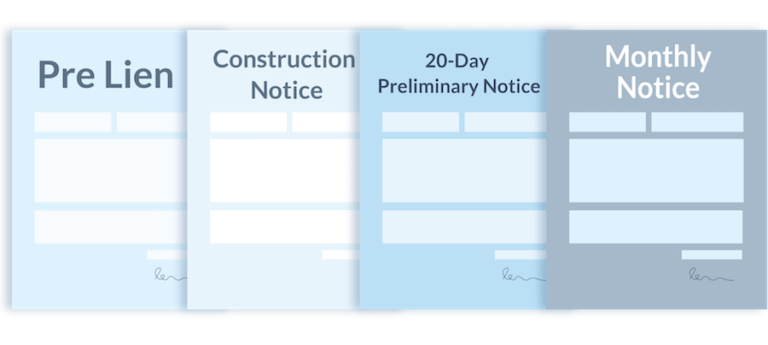What is a Preliminary Notice?
- Notice Resources
Preliminary Notice FAQs
It's common to have questions about notices. There are tons of rules and lots of confusion. Dig through some of the most frequently asked questions here.
Map of Notice Requirements in the US
Quickly see the construction notice rules and requirements in your state with this color-coded US Map of notice requirements.

Watch the video
Learn more about preliminary notices in construction by watching a video that explains the document, and how it's used.
Does your contractor receive notices?
Millions of notices are sent to contractors each year. Odds are that your contractor is receiving notices...and likes it. Search our database to learn about the notice habits of your GC, owner, or lender.
Free Prelim Forms
Get free, fillable PDF preliminary notice forms for your state and project.
Send a Levelset Notice
Make the notice process easy. You can send your notice in seconds with Levelset, and make sure it gets to the right people, the right way, in the right amount of time.
A preliminary notice is a construction notice sent by a contractor, supplier, or equipment lessor to inform the property owner of their work on the project. It is often required by mechanics lien law to establish their right to file a lien if they are not paid. In addition to the owner, a preliminary notice may need to be sent to the lender, general contractor, and other parties at the top of the payment chain.
Many states require subcontractors and suppliers to send preliminary notice in order to preserve their right to file a mechanics lien if they don’t receive payment.
Depending on the location of the project, a preliminary notice may be called a Notice to Owner (NTO), Notice of Furnishing, pre-lien notice, or something similar. They are sent at the start of a construction project before any payment disputes arise, and usually before any payments are due.
This page provides all the information you need to know about preliminary notices, answers frequently asked questions, and provides free preliminary notice forms. Whether you’re collecting and receiving notices, or you’re sending them, this information will help you understand and master the construction notice document and process.
Our Ultimate Guide to Preliminary Notices reveals just how many benefits this document brings to a construction project.
Benefits of sending & receiving preliminary notice
Getting paid in the construction industry is tough, and so the question for contractors and suppliers is simple: How to break through the mess and get your invoices paid? Notices are step one to getting paid in the construction industry.
Faster payments
Preliminary notices help ensure that the property owner and general contractor are aware of every subcontractor and supplier on the job. If they know that a subcontractor is on the job, there’s a greater chance that sub will get paid. Since notices are helpful and promote better project transparency, they have the effect of prioritizing a contractor or supplier’s invoice above others who have not sent the notice, and thus get companies paid more often and more quickly.
More visibility
Those in charge of a project, such as property developers, lenders, and general contractors, look forward to receiving notices from subcontractors and suppliers. Notices give these parties more visibility as to who is contributing to the job. In fact, our research reveals that more than 83% of notice recipients find the documents helpful, or just part of everyday business.
In fact, property owners were largely responsible for the existence of construction notices! In the 60s and 70s, property owners and construction lenders lobbied their governments to help them protect against “surprise liens.” The result of his lobbying was the creation of these pre-lien notices in many states. The purpose was to give owners and lenders the ability to know and track who was on their job, so that they could be proactive to avoid lien claims filed by them.
Better communication
When communication breaks down on a project, it can cause jobsite delays, payment disputes, and costly litigation. Ultimately, a preliminary notice is an effective communication tool that benefits everyone on a project.
Types of Preliminary Notices
States use different names for a preliminary notice, though the function of each is very similar. Sending one of these notices will typically help to protect a party’s lien rights if they are not paid, and improve communication among every stakeholder on a project.
However, every state has their own specific notice deadlines and form requirements. Even states that use the same name for preliminary notices vary greatly in their application.
In addition, it’s common for construction parties to use colloquial names for these documents. They may call it a prelien (as in a “pre-lien notice”) or simply a prelim. These terms are simply a nickname for the state’s preliminary notice.
Notice to Owner (NTO)
The Notice to Owner (NTO) is a preliminary notice document used on construction projects in 13 states: Arkansas, Colorado, Florida, Indiana, Kentucky, Louisiana, Maine, Missouri, Oklahoma, Oregon, Tennessee, Virginia, and Washington.
Notice of Furnishing
A Notice of Furnishing is used in 5 states: Michigan, Ohio, Pennsylvania, South Carolina, and South Dakota.
Notice to Contractor
A Notice to Contractor is used in Georgia, as well as on public projects in Washington.
Other types
Many states refer in their statutes to “preliminary notice.” However, some states have different types of preliminary notice depending on the party’s role, and the type of project. These include:
- Notice of Right to Lien (AK, NV, OR, WI)
- Preliminary 20-day Notice (AZ, CA)
- Notice of Contract (MA, NC)
- Monthly Notice (TX)
- Notice to Owner Prior to Performance (AL)
- Notice of Unpaid Lien (AL)
- Notice to Property Owner (AZ)
- Disburser Notice (CO)
- Notice of Identification (MA)
- Notice of Subcontract (NC)
- 31-Day Notice (NV)
- Notice of Unpaid Balance and Right to Lien (NJ)
- Notice to Lien Agent (NC, VA)
- Notice of Possible Mechanic’s Lien (RI)
- Notice of Preconstruction Services (UT)
- Model Disclosure Statement (WA)
- Subcontractor Identification Notice (WI)
- Preliminary Notice of Right to Lien (WY)
All of the different names, forms, and requirements can seem overwhelming! Don’t panic. We make the requirements – and the preliminary notice process – simple. Choose your project’s state from the map or drop-down menu to learn the rules and download free forms.
We make it even simpler by letting you send notices through Levelset. Enter a few details about your project and we’ll automatically generate the form you need.
Notice requirements
Sometimes, state law requires parties to send preliminary notices in order to preserve their lien rights. These notice laws are complicated and differ significantly from state-to-state and project-to-project. Contractors and suppliers in these states that fail to follow the requirements could lose their right to file a mechanics lien if they aren’t paid. (See: Can You File A Mechanics Lien Without A Preliminary Notice?)
However, because of the benefits it brings, it’s a best practice to send notice on every project – even when it’s not a requirement.
State-by-State
Each state has their own statutes that govern the rules and deadlines for sending notice to protect payment. The rules about sending a “notice to owner” in Florida, for example, are different from the “20-day preliminary notice” requirement in California, and the “monthly notice” in Texas. Notably, New York lacks any notice requirements at all.
Requirements may differ by project type
States often have different rules for different types of construction projects. The state rules may allow notice to be sent long after the job begins on a commercial job. For example, Washington contractors and suppliers have 60 days to send the notice. But the same state may set a different notice deadline for public or state jobs. For example, construction parties must send notice within 10 days on public projects in Washington.
Sending preliminary notice
Most states require subcontractors and suppliers to provide the notice to key project stakeholders like the property owner, the general contractor, and the construction lender.
Delivery methods
Notices must typically be sent by certified mail, certified mail return receipt requested, or by registered mail. You can learn more in this article: What is a pre-lien notice?
Many construction companies already appreciate the benefit of sending and receiving notices. They often have sophisticated policies in place to track deadlines and send or collect notices on every project.
Delivery services
In either case, it’s common for administrators and finance professionals to spend a lot of time doing busy work like researching prelim notice laws, managing notice requirements, and handling the paperwork involved with preparing, mailing, and tracking notices. This is why it’s a good idea to use some type of service (or software) to help better handle notices. Take a look at our review of The 10 Best Nationwide Preliminary Notice Services.
Other notice types
A preliminary notice is typically sent at the beginning of a project, or within a specific amount of time after first providing labor or materials. It’s different from a Notice of Intent (NOI), which some states require after payment is due, but before a party can actually file a mechanics lien.




